
About Andrew Cusack
 Writer, web designer, etc.; born in New York; educated in Argentina, Scotland, and South Africa; now based in London.
Writer, web designer, etc.; born in New York; educated in Argentina, Scotland, and South Africa; now based in London. read more
News
Blogs
Reviews & Periodicals
Arts & Design
World
France
Mitteleuropa
Knickerbockers
Argentina
The Levant
Africa
Cape of Good Hope
Netherlands
Scandinavia
Québec
India
Muscovy
Germany
Academica
Scotland
Written and illustrated by Andrew Cusack (at 7 years of age)
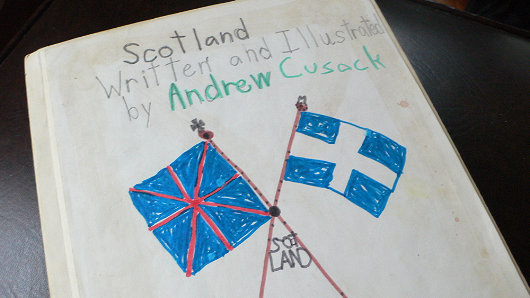
Were I to review this book, I would say it is riddled with inaccuracies and depicts a stereotypical Hollywood version of Scotland far-removed from reality. But then, it was written in 1991 by a seven-year-old (yours truly), which is already eighteen years ago now. The ultimate schoolboy error is that I was apparently incapable at age 7 of producing a vexillologically accurate reproduction of the Saltire. My incorrect version of the Scottish appears like the old Greek flag, a white cross extended across a blue field. (See the correct flag here).
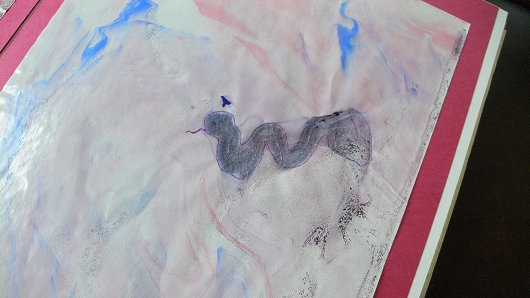
In an arts-and-craftsy way, we had to produce end-papers for the books that replicated the marbling technique you see in many old books. Appropriately enough, one of the squibbles that emerged looked to seven-year-old me like the Loch Ness Monster, and was duly outlined in pen and given a tongue to stick out at the reader.
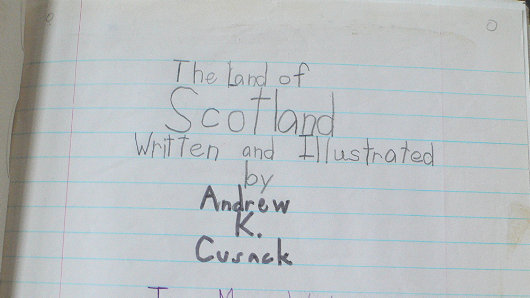
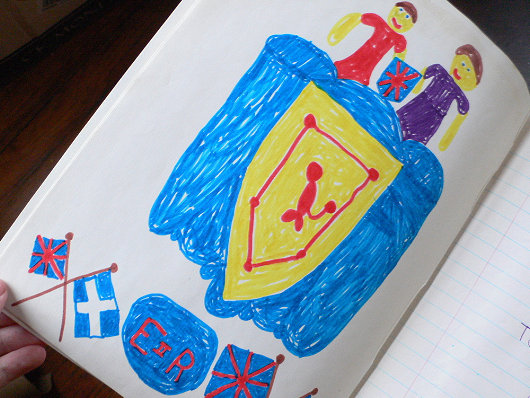
The frontispiece is a depiction of the Scottish arms.
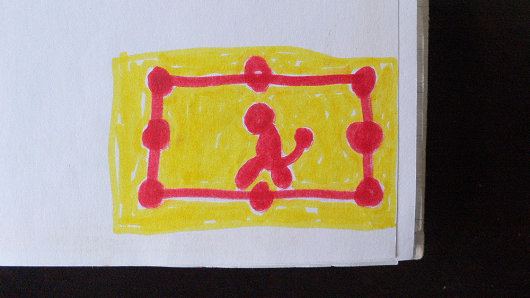
A little Royal Banner of Scotland graces one of the inside pages.
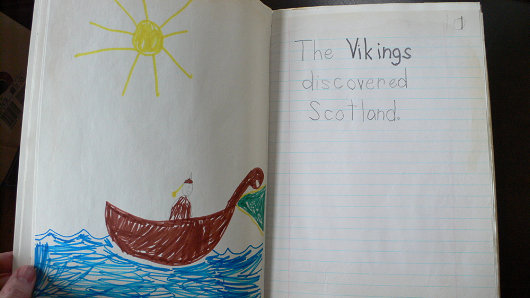
The Vikings, apparently, discovered Scotland.
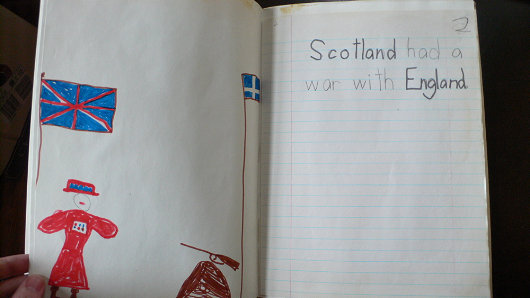
Scotland had a war with England. (That’s a Beefeater at left).
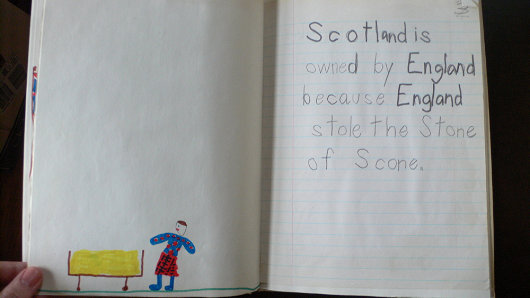
Scotland is owned by England because England stole the Stone of Scone. When I was a kid I thought the Stone of Scone was the coolest thing on God’s green Earth. The first time I saw it would’ve been the summer in between kindergarten and first grade, less than a year before I wrote this “book”, when it rested in the Coronation Chair in Westminster Abbey. My more recent trips to see the Stone of Scone have been to Edinburgh Castle after it was returned, with much pomp and ceremony, to its rightful home in 1996.

The Stone of Scone is the stone that Scottish kings and queens are crowned on. Judging by the stylized “M”, I’m guessing that this is supposed to be Mary, Queen of Scots.
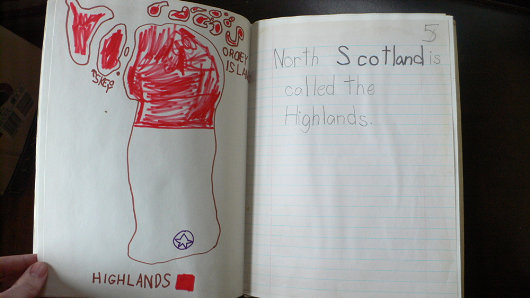
North Scotland is called the Highlands.
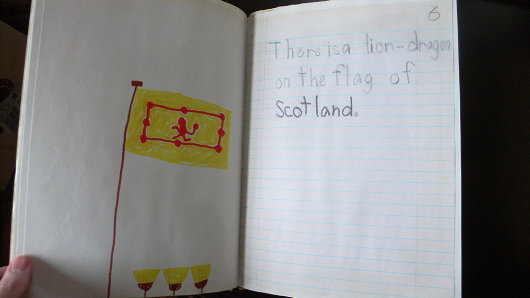
There is a lion-dragon on the flag of Scotland. Wrong! Not only is it a lion, not a lion-dragon, but this is not the flag of Scotland, but rather the Royal Banner. Its use as a national flag used to be widespread, though the more correct use of the Saltire has grown. The Crown has instructed Lord Lyon King of Arms that, while strictly speaking only the Monarch may legitimately use this flag, its use by loyal subjects is not to be formally prosecuted.
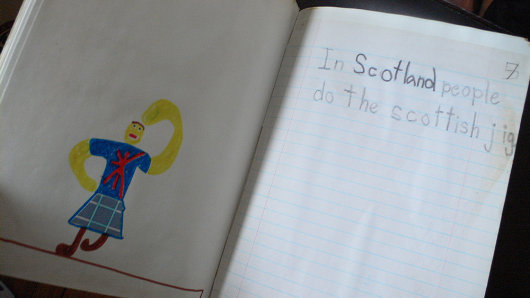
In Scotland people do the Scottish jig. Constantly. Unceasingly. It’s very hard to keep up with them, to be honest.
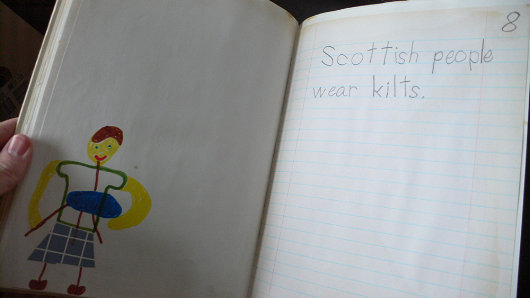
Scottish people wear kilts. And play the bagpipes too, if the illustration is anything to go by.
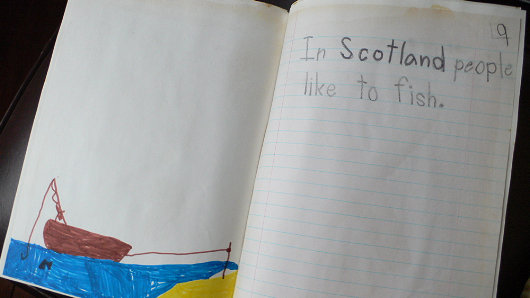
In Scotland people like to fish. They do this by attaching their rowboat to a stick in the shore, fixing their pole, and having a nap.
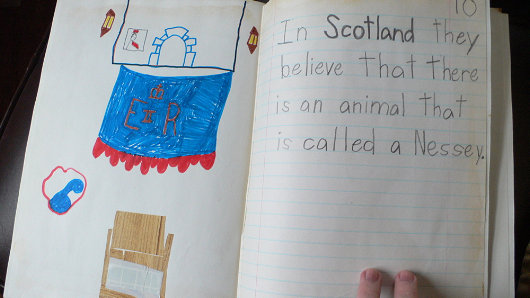
In Scotland they believe that there is an animal called a Nessey (sic, Nessie). The Loch Ness Monster was also something I was very fond of when I was a young’un.
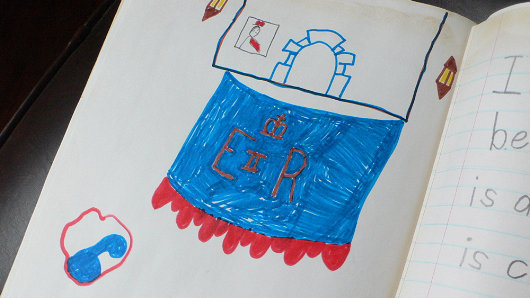
My idea was that the Loch Ness Monster had broken through a wall in some palace and was sticking its head through. Note the portrait of Queen Victoria beside the arched doorway in the gallery above the regal monogram.
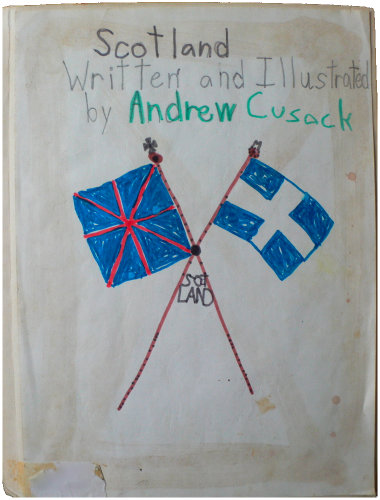
The End!
Search
Instagram: @andcusack
Click here for my Instagram photos.Most Recent Posts
- Silver Jubilee November 21, 2024
- Articles of Note: 11 November 2024 November 11, 2024
- Why do you read? November 5, 2024
- India November 4, 2024
- The Lithe Efficiency of the Old Constitution November 4, 2024
Most Recent Comments
Book Wishlist
Monthly Archives
Categories



“My incorrect version of the Scottish appears like the old Greek flag”
Maybe you were subconsciously influenced by your simultaneous correspondence with the exiled King of Greece? Or was that a year later?
Well, I think that is a very nice story, Andrew. B.A. and I are furious that you were only 7 in 1991. Curses! Curses!
“My more recent trips to see the Stone of Scone have been to Edinburgh Castle after it was returned, with much pomp and ceremony, to its rightful home in 1996.”
Ah, but is it really the Stone of Scone…
“In Scotland people like to fish.”
With a rod is still fine, but if you are a fishing boat you’ll find you can fish the sixth Friday of every month and anything that is classified as a ‘fish’ you have to throw back, by order of our EU friends. As you throw it back you’ll probably see an non – EU boat hoovering everything up…
Liz, I think I was 10 when I sent the note of commiseration to H.M. the King of the Hellenes.
You had a nice handwritting. Nowadays it is better?
There is much to be celebrated in your early work. Firstly, you have given an impression of the Union Jack, without the cross of St. Andrew, but still retaining the blue background of the Saltire – a possible future design for the post independence era? In addition, on page two, the ‘Saltire’ is flying higher than the Union Jack and Scotland’s superior firearm capabilities are being demonstrated. It is however a pity that there is not a Scotsman to fire the weapon. Is he a lazy west coast trade union activist, or is he showing initiative and bringing the Stone home on page three instead? Furthermore, page five shows that there has been significant geographical expansion – the people of Berwick-upon-Tweed will be happy! An excellent read! I must get on with more ‘jigging’.
Man, I love this blog.
Were you always a good speller, or did you have a wee bit of help? I will also not that this could be the first appearance on your blog of a middle initial.
And what, pray, does the ‘K’ stand for?
Andrew, don’t lie. This is clearly your fourth year dissertation.
Steve M, middle initials are clearly visible here:
http://www.andrewcusack.com/about/
This post couldn’t have made me more happy. I love it! And I remember this book. Thanks for putting this out there in the world!
Thats how cusack got the nickname ‘killer beast’, from the K. B.
Oh you were such an entertaining child. I too love this book just a hint of your future association with Scotland.
Liz S, Since I have been a reader of the blog for years, I had never clicked on this nifty new “about” page–I certainly stand corrected. Although we now have the mystery of why Andrew, at age 7, was supressing one of his two middle initials.
If I may be so bold as to address a question to Mrs. Cusack–Did this book factor into your decisive role in steering Andrew towards a university in Scotland?
No Steve the idea of attending St Andrew’s was all Andrew’s however after visiting the venerable institution there was powerful lobbying on my part for Andrew to accept the place he’d been offered.
Are those three thistles under “the lion-dragon on the flag of Scotland”?
Steve M- He didn’t gain the second middle initial until his confirmation, so he wasn’t actually hiding anything name-related at the time of the book writing. Sorry to ruin any potential mystery for you!
I love the map of the Highlands. Some might (anachronously) say that Pytheas of Massilia would have copied this early Andrew’s travail when fantasizing about Thule.
I am compelled to come back nearly three months after I read this to remark on this brilliant piece. I am reminded of an equally incorrect book on skyscrapers I wrote at the same age. Is there any reason the Scottish soldider pictured next to the Beefeater on Page 2 looks like either a mound of dirt, a dung-dropping, or a grossly misshaped hedgehog?
I didn’t know you already loved Scotland at that young age. I guess it was really your vocation to go to St. Andrew’s.